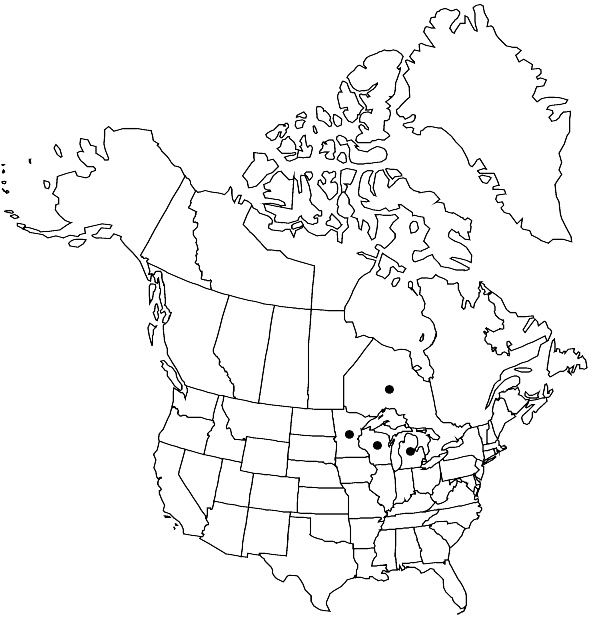Difference between revisions of "Trichostomum spirale"
Moss Fl. N. Amer. 1: 162, plate 84, fig. B. 1938,.
FNA>Volume Importer |
imported>Volume Importer |
||
| (6 intermediate revisions by 2 users not shown) | |||
| Line 10: | Line 10: | ||
|name=Oxystegus spiralis | |name=Oxystegus spiralis | ||
|authority=(Grout) H. A. Crum & L. E. Anderson | |authority=(Grout) H. A. Crum & L. E. Anderson | ||
| − | }}{{Treatment/ID/Synonym | + | |rank=species |
| + | }} {{Treatment/ID/Synonym | ||
|name=Oxystegus tenuirostris var. stenocarpus | |name=Oxystegus tenuirostris var. stenocarpus | ||
|authority=(Thériot) R. H. Zander | |authority=(Thériot) R. H. Zander | ||
| + | |rank=variety | ||
}} | }} | ||
|hierarchy=Pottiaceae;Pottiaceae subfam. Trichostomoideae;Trichostomum;Trichostomum spirale | |hierarchy=Pottiaceae;Pottiaceae subfam. Trichostomoideae;Trichostomum;Trichostomum spirale | ||
| Line 27: | Line 29: | ||
|habitat=Rotten wood | |habitat=Rotten wood | ||
|distribution=Ont.;Mich.;Minn.;Wis.;Mexico;Asia. | |distribution=Ont.;Mich.;Minn.;Wis.;Mexico;Asia. | ||
| − | |discussion=<p>R. H. Zander (1982, 1994d) treated Trichostomum spirale as a variety of T. tenuirostre (as Oxystegus tenuirostris), but the autoicous inflorescence seems significant in that differences in sexuality at the level of dioicy and monoicy are commonly found at the species level in Pottiaceae; also, the plants are slightly smaller in size and the distal medial laminal cells seem smaller (8–10 µm wide). H. A. Crum and L. E. Anderson (1980–1983) provided a summary of the problems associated with T. spirale; they noted that the spiral ornamentation of the peristome of this taxon is usually basal on the peristome teeth which may be papillose distally (as in T. tenuirostre) or completely smooth, while Zander (1982) found that peristomes of the types of T. spirale and its Mexican synonym Weisiopsis stenocarpum Thériot are within the range of variation of T. tenuirostre, which has variably smooth, low-spiculose, or spirally spiculose or ridged peristome teeth.</p> | + | |discussion=<p>R. H. Zander (1982, 1994d) treated <i>Trichostomum spirale</i> as a variety of <i>T. tenuirostre</i> (as Oxystegus tenuirostris), but the autoicous inflorescence seems significant in that differences in sexuality at the level of dioicy and monoicy are commonly found at the species level in <i>Pottiaceae</i>; also, the plants are slightly smaller in size and the distal medial laminal cells seem smaller (8–10 µm wide). H. A. Crum and L. E. Anderson (1980–1983) provided a summary of the problems associated with <i>T. spirale</i>; they noted that the spiral ornamentation of the peristome of this taxon is usually basal on the peristome teeth which may be papillose distally (as in <i>T. tenuirostre</i>) or completely smooth, while Zander (1982) found that peristomes of the types of <i>T. spirale</i> and its Mexican synonym Weisiopsis stenocarpum Thériot are within the range of variation of <i>T. tenuirostre</i>, which has variably smooth, low-spiculose, or spirally spiculose or ridged peristome teeth.</p> |
|tables= | |tables= | ||
|references= | |references= | ||
| Line 36: | Line 38: | ||
-->{{#Taxon: | -->{{#Taxon: | ||
name=Trichostomum spirale | name=Trichostomum spirale | ||
| − | |||
|authority=Grout | |authority=Grout | ||
|rank=species | |rank=species | ||
| Line 50: | Line 51: | ||
|publication year= | |publication year= | ||
|special status= | |special status= | ||
| − | |source xml=https:// | + | |source xml=https://bitbucket.org/aafc-mbb/fna-data-curation/src/2e0870ddd59836b60bcf96646a41e87ea5a5943a/coarse_grained_fna_xml/V27/V27_712.xml |
|subfamily=Pottiaceae subfam. Trichostomoideae | |subfamily=Pottiaceae subfam. Trichostomoideae | ||
|genus=Trichostomum | |genus=Trichostomum | ||
Latest revision as of 22:28, 5 November 2020
Stem rounded-pentagonal in section. Leaves flattened, short-lanceolate to lanceolate, distal margins plane, entire, not bordered; apex acute, plane or keeled; basal cells differentiated across leaf base as a U or V, commonly running up margins, not distinctly enlarged submarginally; distal laminal cells pluripapillose with low papillae; mucro conic, of 3–6 cells. Sexual condition autoicous. Peristome bluntly lanceolate.
Phenology: Capsules mature fall.
Habitat: Rotten wood
Distribution

Ont., Mich., Minn., Wis., Mexico, Asia.
Discussion
R. H. Zander (1982, 1994d) treated Trichostomum spirale as a variety of T. tenuirostre (as Oxystegus tenuirostris), but the autoicous inflorescence seems significant in that differences in sexuality at the level of dioicy and monoicy are commonly found at the species level in Pottiaceae; also, the plants are slightly smaller in size and the distal medial laminal cells seem smaller (8–10 µm wide). H. A. Crum and L. E. Anderson (1980–1983) provided a summary of the problems associated with T. spirale; they noted that the spiral ornamentation of the peristome of this taxon is usually basal on the peristome teeth which may be papillose distally (as in T. tenuirostre) or completely smooth, while Zander (1982) found that peristomes of the types of T. spirale and its Mexican synonym Weisiopsis stenocarpum Thériot are within the range of variation of T. tenuirostre, which has variably smooth, low-spiculose, or spirally spiculose or ridged peristome teeth.
Selected References
None.